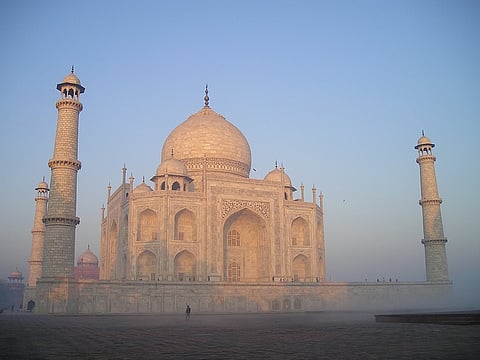Taj Mahal: The Iconic Mausoleum Of Love Is Becoming A Victim Of Man And Nature
Agra, April 3 (TNA) India's tourism icon and a symbol of earthly love, the 17th century white marble mausoleum, the Taj Mahal in Agra, is a victim of both nature and man. The scorching summer heat, the sand from the heavily polluted Yamuna river, dry dust from the neighbouring Rajasthan desert, and the continuously increasing human load, are affecting the health of the monument.
If the monument looks sick and pale to visitors the reason is the dry and heavily polluted Yamuna that once formed an integral part of the Taj Mahal complex. Says Surendra Sharma, president of the Braj Mandal Heritage Conservation Society, “ in the scorching summer sun the monument of love is enveloped in yellowish sand from the neighbouring Rajasthan desert. Any discernible visitor can tell that the summer heat is taking its toll on the Taj Mahal, the timeless monument of love, blasted by sand from the dry Yamuna bed and the dust-laden winds from the Rajasthan desert.”
The gaps left by illegal mining in the Aravali ranges has raised the SPM (suspended particulate matter) in Agra. Against a standard of 100 microns per cubic metre, it remains as high as 300 touching 500 during summer months. The problem is that sandy particles rub against the monument and leave pock marks making the surface rough, as has been pointed out by several experts committee reports.
However, conservationists say that the crisis the Taj confronts comes not merely from nature and pollution but also from people themselves - too many tourists and too many vehicles that bring them to Agra. The number of vehicles in the city has shot up from around 40,000 in 1985 when Firozabad too was part of the Agra district, to now more than a million.
The opening of the Yamuna Expressway has increased vehicular traffic. The pressure of heavy vehicles on the Delhi-Kolkata, Agra-Lucknow and Delhi-Mumbai national highways passing through Agra, has increased phenomenally.
Adding to its fatigue is the ever-increasing human load. From a few hundred daily some decades ago, the Taj is daily visited by thousands now. Visitors, who see the Taj Mahal for the first time never forget to ask the guides "is it turning yellow?"
The explanation given by the guides is that the perceived discolouration is due to the ageing process which is natural and has nothing to do with industrial pollution, as all polluting industries in the Agra region have been shut down by the Supreme Court.
To ensure dazzling whiteness and remove stains left behind by pollutants on the Taj Mahal, originally called Bagh-e-Baahist, a heavenly garden, the Archaeological Survey of India carries out periodic multani mitti (Fuller's earth) treatment. The white marble surface is washed with soap and water too on Fridays when the monument breathes freely to enjoy its weekly off.
Only a few tourists are genuinely aware of the historic significance of the monument and its great heritage value, there are hordes of others who care nothing for the sanctity of the Taj.
When thousands of tourists 'invade' the serene monument every day, leaving behindhand and foot marks on the white stones, and tons of noxious gases through breathing, the cumulative affect on the fragile structure is huge.
The number of tourists, since February 2020 has sharply decreased as a result of the Covid-19 pandemic. During the 180 day closure of the monument last year, the Taj Mahal breathed free for the first time and appeared fresh with vigour. The foreign visitors are few even now, as the international flights remain suspended.
A series of measures taken recently by the ASI, May help crowd management and perhaps bring down the human load, it is the pathetic state of the Yamuna river that is worrying heritage conservationists in Agra. According to Ved Goutam, a tour guide, Agra has already become a desert. "When you see camels moving around on the dry river bed, one gets the impression that Agra is in a desert, a part of the Rajasthan state," he said.
The Archaeological Survey of India (ASI) has restored the Mehtab Bagh at the rear of the Taj Mahal and the state forest department has developed a dense green buffer along the river bank on the opposite side.
But the major problem is the Yamuna, which has been reduced to a "sewage canal.” Bacteria breeding in pools of polluted water in the river, frequently leave greenish patches at the rear side of the Taj facing the river. These have to be washed with water every few days.
Successive governments at the centre and in Lucknow, have done nothing to rejuvenate Yamuna. A barrage downstream of the monument was to have been built several years ago, but lack of coordination among various government departments has been delaying the project.
"If there is no fresh supply of water in the river that touches the Taj foundation to provide a shock-absorbing buffer to insulate the building from seismic movements, the fear is that the monument could tilt, cave in or struggle for stability," fear heritage conservationists.

